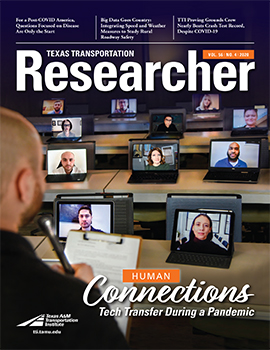By Ginger Goodin
Recent news that preventive COVID-19 vaccines may soon be available suggests that we’re one step closer to answering one of the more dominant questions of our daily lives: How can we avoid falling victim to one of the most destructive diseases ever?
And while that’s clearly the biggest question related to the pandemic, it’s far from being the only one. What’s gotten less attention are the questions of how and where we are likely to work, live and shop once this global crisis is behind us. All three of those activities require a robust transportation system, and all three have changed dramatically in recent months. That much we know. What we don’t yet know is how to ensure that our transportation system is prepared to support our existence in a post-pandemic nation.
That’s the goal of research we’re now doing at the Texas A&M Transportation Institute (TTI).

Many of us at TTI, like so many others, are doing that work largely if not exclusively from our homes or other non-office environments. Some organizations may elect to make work-from-home a permanent practice. Any lasting shift to telecommuting could in turn reduce traffic congestion, traffic crashes, vehicle emissions and other negative factors. It’s also likely to cause long-term erosion in public transit use, keenly important to many of the people whom we’ve come to regard as essential workers.
Choices of how and where we work naturally will influence where we choose to live. Pandemic-influenced changes in work culture may be a factor in Texas’ sharp increase in home sales, a potential indicator of the long-term adoption of behaviors like telecommuting or home relocation, which can lead to changing patterns of land use as people move to suburban communities or beyond. These dispersed land development patterns make transit service more challenging to provide, increase dependency on personal autos, and result in greater roadway infrastructure needs and greater burdens on low-income travelers in terms of the personal costs to own a vehicle.
While the number of work-related trips has declined, the opposite has been true for the movement of goods, seen especially in the increasingly stronger consumer demand for deliveries that has made freight trips both shorter and more frequent. Even as e-commerce deliveries have grown during our public health crisis, the pandemic has at the same time exposed a critical vulnerability in the supply chains that feed those deliveries. Certain industries are already exploring adjustments that would reduce Asian trade reliance and make supply chains more resilient, and therefore deliveries more reliable. Our research shows that if 25 percent of China’s exports to the United States were sourced to Mexico, international truck and rail border crossings between the United States and Mexico would increase by more than 40 percent, exacerbating already serious border traffic gridlock.
Our greatest public health crisis in more than a century has already changed how and where we work, live and shop. And even after we emerge from our isolated and socially distanced reality, those changes are, to at least some degree, likely to persist and raise questions that require thoughtful and well-informed answers.
- To what extent will telecommuting become a norm, and what will the resulting impact be on our travel and our need for road construction and maintenance?
- Is the increase in home sales during the pandemic primarily happening in suburban and exurban areas, and if so, what would a shift in space demand mean for the ways in which our transportation systems are planned and developed in the future?
- Will e-commerce maintain its current growth trajectory, and if so, what does that mean for delivery demand and its impact on streets and highways?
These are only a few of the questions we need to be asking now. Issues related to equity and environmental justice, transportation funding, air quality, and other topics also merit our attention, so we’re working on those, as well. The pursuit of answers requires us to choose science over speculation, just as those working to develop a preventive pharmaceutical have had to do.
The search for a vaccine has always been concerned with if we’re going to live through the pandemic; the questions that remain will largely determine how we’re going to live beyond it.

